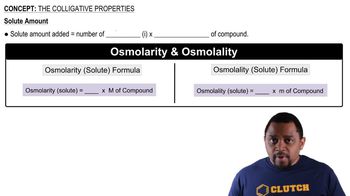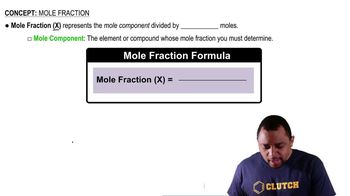You make a solution of a nonvolatile solute with a liquid solvent. Indicate if each of the following statements is true or false. (a) The freezing point of the solution is unchanged by addition of the solvent.
Ch.13 - Properties of Solutions
Chapter 13, Problem 63
Consider two solutions, one formed by adding 10 g of glucose (C6H12O6) to 1 L of water and the other formed by adding 10 g of sucrose (C12H22O11) to 1 L of water. Calculate the vapor pressure for each solution at 20 °C; the vapor pressure of pure water at this temperature is 17.5 torr.
 Verified step by step guidance
Verified step by step guidance1
Step 1: Calculate the molar mass of glucose (C6H12O6) by adding the atomic masses of its constituent atoms: 6 carbon atoms, 12 hydrogen atoms, and 6 oxygen atoms.
Step 2: Calculate the number of moles of glucose by dividing the mass of glucose (10 g) by its molar mass.
Step 3: Calculate the molar mass of sucrose (C12H22O11) by adding the atomic masses of its constituent atoms: 12 carbon atoms, 22 hydrogen atoms, and 11 oxygen atoms.
Step 4: Calculate the number of moles of sucrose by dividing the mass of sucrose (10 g) by its molar mass.
Step 5: Use Raoult's Law to calculate the vapor pressure of each solution. Raoult's Law states that the vapor pressure of the solution is equal to the mole fraction of the solvent multiplied by the vapor pressure of the pure solvent. Calculate the mole fraction of water in each solution and then use it to find the vapor pressure.
Key Concepts
Here are the essential concepts you must grasp in order to answer the question correctly.
Colligative Properties
Colligative properties are physical properties of solutions that depend on the number of solute particles in a given amount of solvent, rather than the identity of the solute. These properties include vapor pressure lowering, boiling point elevation, freezing point depression, and osmotic pressure. In this question, the vapor pressure lowering of water due to the addition of glucose and sucrose is a key focus.
Recommended video:
Guided course

Colligative Properties
Vapor Pressure
Vapor pressure is the pressure exerted by a vapor in equilibrium with its liquid or solid phase at a given temperature. When a non-volatile solute, like glucose or sucrose, is added to water, the vapor pressure of the solution decreases compared to that of pure water. This decrease is proportional to the concentration of the solute particles in the solution.
Recommended video:
Guided course

Raoult's Law and Vapor Pressure
Mole Fraction
Mole fraction is a way of expressing the concentration of a component in a mixture, defined as the ratio of the number of moles of that component to the total number of moles of all components in the mixture. In calculating the vapor pressure of the solutions, the mole fraction of water in each solution is used to determine how much the vapor pressure is lowered due to the presence of glucose or sucrose.
Recommended video:
Guided course

Mole Fraction Formula
Related Practice
Textbook Question
Textbook Question
You make a solution of a nonvolatile solute with a liquid solvent. Indicate if each of the following statements is true or false. (b) The solid that forms as the solution freezes is nearly pure solute.
Textbook Question
You make a solution of a nonvolatile solute with a liquid solvent. Indicate if each of the following statements is true or false. (d) The boiling point of the solution increases in proportion to the concentration of the solute. (e) At any temperature, the vapor pressure of the solvent over the solution is lower than what it would be for the pure solvent.
Textbook Question
The vapor pressure of pure water at 60 °C is 149 torr. The vapor pressure of water over a solution at 60 °C containing equal numbers of moles of water and ethylene glycol (a nonvolatile solute) is 67 torr. Is the solution ideal according to Raoult's law?
